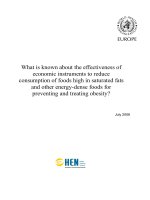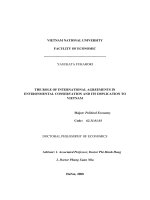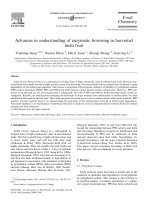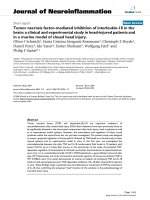Bacterial laccase mediated inhibition of enzymatic browning in apple juice and its sensory evaluation
Bạn đang xem bản rút gọn của tài liệu. Xem và tải ngay bản đầy đủ của tài liệu tại đây (304.91 KB, 11 trang )
Int.J.Curr.Microbiol.App.Sci (2018) 7(1): 3371-3381
International Journal of Current Microbiology and Applied Sciences
ISSN: 2319-7706 Volume 7 Number 01 (2018)
Journal homepage:
Original Research Article
/>
Bacterial Laccase Mediated Inhibition of Enzymatic Browning
in Apple Juice and its Sensory Evaluation
Ambika Verma1*, Poonam Shirkot1, Karuna Dhiman1, Neerja Rana2 and V.K. Joshi3
1
Department of Biotechnology, 2Department of Basic Sciences, 3Department of Postharvest
Technology, Dr. Y. S. Parmar University of Horticulture and Forestry, Nauni, Solan-173230
(H.P.), India
*Corresponding author
ABSTRACT
Keywords
Laccase, Apple
juice, Phenolics,
Clarification,
Sensory evaluation
Article Info
Accepted:
26 December 2017
Available Online:
10 January 2018
The present study deals with inhibition of enzymatic browning in apple juice by laccase
enzyme of Pseudomonas putida LUA15.1, which was purified by using ammonium sulfate
precipitation, dialysis, gel filtration chromatography and ion exchange chromatography.
Purified laccase enzyme preparation was able to eliminate undesirable phenolics and
resulting in clarification of apple juice, in addition to prevention of browning of apple
slices/cubes successfully. One percent concentration of purified laccase enzyme
preparation was the most acceptable concentration in order to maintain colour, flavour,
taste and overall acceptability of apple juice in the present study. Overall, the results
clearly revealed that the use of laccases for apple juice clarification is useful. The
application of laccase has improved the clarity of apple juice and also improving its
sensory quality characteristics. Thus, it has a large potential for the application in juice
processing industry.
Introduction
Laccases (EC 1.10.3.2.) are a group of
multicopper enzymes, conferred significant
attention due to their ability to oxidize
phenolic and nonphenolic compounds, making
them very useful for various applications in
several biotechnological processes. In the food
industry, laccase finds application in different
processes like fruit juice processing, wine
stabilization, sugar beet pectin gelation,
baking and in improving food sensory
parameters (Minussi et al., 2002). It is well
known that browning, both enzymatic and
chemical, is one of the major faults in
beverages (Giovanelli and Ravasini, 1993).
The color and taste of fruit juices depend
particularly on the phenolic compounds which
should be selectively removed to prevent any
alterations in taste and colour imparted mainly
by the oxidation of polyphenols. Various pre
and post treatments are available to avoid
post-turbidity and discoloration of fruit juices.
Different methods have also been used in
order to prevent the decolorization and flavor
alteration in beverages such as the removal of
3371
Int.J.Curr.Microbiol.App.Sci (2018) 7(1): 3371-3381
phenolic
groups
with
polyvinyl
polypyrrolidone, and the use of sulfur dioxide
to block oxidizers, among others (Minussi et
al., 2002). An alternative for the physical and
chemical adsorbents could be the use of
enzymes that selectively target specific
polyphenols during the maderization process.
These polyphenolic substances would be
oxidized by the enzymes, polymerized and
then removed by clarification, and laccases
has been effectively used for this purpose,
because laccases have potential to eliminate
undesirable phenolics, responsible for
browning, haze formation and turbidity
development in various beverages such as
clear fruit juice, beer and wine (Cantarelli and
Giovanelli,
1990).Various
enzymatic
treatments have been proposed for fruit juice
stabilization, including the use of laccase
(Piacquadio et al., 1998). There are several
studies in the literature which state that
laccase treatment promotes wine stabilization
(Cantarelli and Giovanelli, 1990; Plank and
Zent, 1993; Servili et al., 2000). Some studies
also shown that wines made by laccase
treatment were the best and suggesting that a
stable as well as high quality wine can be
made with little or no added SO2 and
feasibility of using laccase for phenol removal
from white must have also been suggested
(Maier et al., 1990; Minussi et al., 2007).
Earlier studies reported various prefermentation techniques to analyze the
variation in polyphenolic compounds, color
parameters, and aromatic components of
wines (Moreno-Pérez et al., 2013; Wang et
al., 2016).
Apple juice is one of the most frequently
consumed juices and a large part of harvested
apples are processed to apple juice every year.
Apple juice has been the most important topic
of study due to its very high demand (Ozoglu
et al., 2002), but enzymatic browning is one of
the main causes of its quality loss. Phenolic
compounds and their oxidative products
present naturally in the fruit juice have been
found to give colour and taste to the juice.
Colour and aroma changed from an oxidation
of phenolic and polyphenolic compounds by
polyphenol oxidases to o-quinones, and a
subsequent polymerization to insoluble
browning pigments of melanins (Berregi et al.,
2003). These changes have been reported due
to the high concentration of polyphenols and
referred to as enzymatic darkening. Laccase
treatment has been found to remove phenols
by the help of membrane filtration and hence,
achieved colour stability.
Stutz (Stutz, 1993) has also been found to
produce clear and stable juice concentrates
with a light colour by means of ultrafiltration
and laccase, without any large additional
investment. Similarly, in another studies,
laccase enzyme based clarification and
stabilization of apple fruit juice have been
reported (Ritter and Dietrich, 1996;
Piacquadio et al., 1998; Bezerra et al., 2015;
Lettera et al., 2016).
Sensory qualities of apple juice have also been
described to be the most important factor for
its high demand (Ozoglu et al., 2002) and the
good sensory qualities of apple juice have
been considered by consumers to be most
important factor than price (Harker et al.,
2002). Enzymatic browning has not only a
negative effect on colour, but also impairs the
various other sensory properties including
taste, odour, texture etc. (Martinez et al.,
1995). Many researchers have also paid
attention to the changes in the qualities and the
methods for preventing the qualitylosses of the
product (Ozoglu et al., 2002; Joshi et al.,
2011). In the present study, purified laccase
enzyme preparation of Pseudomonas putida
LUA15.1 was assessed for its ability to
eliminate undesirable phenolics from both
apple cubes and apple fruit juice, responsible
for browning and turbidity development with
respect to its preferable sensory evaluation.
3372
Int.J.Curr.Microbiol.App.Sci (2018) 7(1): 3371-3381
Materials and Methods
Bacterial isolate and its maintenance
The bacterial isolate used in study was
Pseudomonas putida LUA15.1, which was
isolated from rice rhizospheric soil samples of
paddy fields of Una district, Himachal Pradesh
(India) in the previous study, maintained and
preserved in Tryptone Yeast (TY) medium at
4°C. Tryptone Yeast medium (Givaudan et al.,
1993; Sowinski et al., 2002)had the following
composition: Tryptone 5.0 g, Yeast Extract
3.0 g, 1M CaCl2 Solution 10 ml, CuSO4 50
mg, 5mM Guaiacol and distilled water to
make one litre having pH 7.0 All the media
components were procured from SRL,
Mumbai (India).
Laccase production and its purification
Pseudomonas putida LUA15.1 culture was
inoculated into the Tryptone Yeast (TY) broth
and mixed thoroughly by keeping the flasks
on a rotary shaker at 150 rpm for 24 hours at
28oC. The culture supernatant was obtained by
centrifugation of overnight culture of
Pseudomonas putida LUA15.1 at 10,000 rpm,
for 10 minutes at 4oC. This culture supernatant
was used as crude extracellular laccase
enzyme which was further purified by
ammonium sulfate precipitation, dialysis, gel
filtration chromatography and ion exchange
chromatography techniques. The activity of
the purified laccase after each step of
purification was determined by monitoring the
oxidation of ABTS (Faramarzi and
Forootanfar, 2011).
Laccase activity assay
Laccase
activity
was
determined
spectrophotometrically at 420 nm with ABTS
as a substrate. Catalase was added to the assay
solution and incubated for 1 hr at 37oC to
remove the possible effect of H2O2 produced
by the bacterial isolate. The reaction mixture
contained 200 µl aliquots of extracellular
enzyme preparation and 0.2 mM ABTS in 0.1
M sodium acetate buffer (pH 4.5) making final
volume to 1.0 ml. The reaction was held at
32oC for 10 mins followed by addition of 0.5
ml of 80% trichloroacetic acid to stop the
reaction. One unit of enzyme was defined as
the amount of enzyme required to oxidize 1.0
µmol of ABTS per min. The molar extinction
coefficient of ABTS was found to be 36,000
M-1 cm-1.
Clarification of apple juice
Purified laccase enzyme preparation was
assessed for its ability to eliminate undesirable
phenolics from both apple cubes and apple
fruit juice, responsible for browning and
turbidity development. In case of apple cubes,
fresh apples were peeled and cut into small
cubes in order to make treatment of these
cubes with purified laccase enzyme
preparation and one control was run in parallel
without any treatment, followed by incubation
at room temperature for 48 hrs. Effect of
browning was observed visually on the apple
cubes up to 48 hrs. To study the effect of
purified laccase enzyme preparation on apple
juice, fresh apple juice was extracted with the
help of crusher and filtered by musline cloth
which
was
treated
with
different
concentrations of purified laccase enzyme
preparation (0.2, 0.4, 0.6, 0.8 and 1.0%) and
one control was run in parallel without the
addition of laccase enzyme preparation
followed by incubation at room temperature
for one week. Browning or turbidity
development in apple juice was observed up to
48 hrs.
Sensory evaluation
Sensory quality is a criterion for determining
the acceptability of any food or food product
by the consumers. Overall acceptability of
3373
Int.J.Curr.Microbiol.App.Sci (2018) 7(1): 3371-3381
food in addition to quality and nutritional
attributes also depends on the sensory quality.
The quality of apple juice was evaluated by
sensory evaluation in interval of every 24 hrs
for 7 days although the apple juice were hot
fill and aseptic pack in air tight tubes so
aseptically withdrawal of sample has been
taken for avoiding contamination in aseptic
environment. Consumer preferences for the
experimental apple juice samples were found
out through sensory evaluation performed at
different intervals during storage by a panel of
judges. The panelists were given coded
samples consisting of apple juice for giving
their views on overall acceptability of the fruit
juice on the basis of appearance, flavor and
taste. The sensory parameters of colour,
flavour, taste and overall acceptability were
evaluated based on 9 point Hedonic rating
scale with maximum score considered as the
best for apple juice (Wills et al., 1980).
Results and Discussion
Production and purification of laccase
enzyme from Pseudomonas putida LUA15.1
Pseudomonas putida LUA15.1 culture was
inoculated into the Tryptone Yeast (TY) broth
and mixed thoroughly by keeping the flasks
on a rotary shaker at 150 rpm for 24 hours at
28oC. The culture supernatant was obtained by
centrifugation of overnight culture of
Pseudomonas putida LUA15.1 at 10,000 rpm,
for 10 minutes at 4oC. This culture supernatant
was used as crude extracellular laccase
enzyme which was subjected to ammonium
sulphate (0-90%) saturation and it was found
out that maximum laccase enzyme activity
was detected in 50-90 percent level of
saturation. The enzyme preparation at this
stage was treated as ammonium sulphate
fraction (ASF). The ASF (proteins precipitated
after the overnight dialysis of 50-90%
ammonium sulphate cut) exhibits the highest
rate of precipitation and purified the enzyme
20.56 times with a 68.17% yield and was
applied on Sephadex G-100 column
equilibrated with sodium phosphate buffer
(pH 6.5), purified the enzyme 28.30 times
with a 32.69% yield. And in the last step, the
enzyme fractions obtained and concentrated
from Sephadex G-100 column were applied to
the DEAE sephadex ion exchange column. It
was found that laccase fractions were eluted
with 1.0 M NaCl gradient which further
purified laccase with 48.49 times purification
and 10.08% yield. Laccases have also been
produced and purified from various bacterial
isolates
like
Azospirillum
lipoferum,
Marinomonas mediterranea, Bacillus subtilis,
γ-Proteobacterium JB, Brevibacillus sp. (Z1),
Serratia marcescens (MTCC 4842), Bacillus
subtilis MTCC 2414, Bacillus tequilensis SN4
using ammonium sulphate precipitation, gel
filteration chromatography, Sephadex G-100,
DEAE-cellulose
chromatography
etc
(Diamantidis et al., 1999; Martins et al., 2002;
Bains et al., 2003; Bozoglu et al., 2013; Kaira
et al., 2015; Muthukumarasamy et al., 2015;
Sondhi et al., 2015).
Clarification of apple juice and its sensory
evaluation
Purified laccase enzyme preparation of
Pseudomonas putida LUA15.1 was assessed
for its ability to eliminate undesirable
phenolics from both apple cubes and apple
fruit juice, responsible for browning and
turbidity development and it has been
observed that purified laccase enzyme
preparation of Pseudomonas putida LUA15.1
has been able to eliminate undesirable
phenolics and resulted in clarification of apple
juice, in addition to prevention of browning of
apple slices/cubes successfully (Figure 1).
For sensory evaluation, effect of purified
laccase enzyme preparation on apple juice was
assessed. Fresh apple juice was extracted and
treated with different concentrations of
3374
Int.J.Curr.Microbiol.App.Sci (2018) 7(1): 3371-3381
purified laccase enzyme preparation in the
range 0.2-1.0% and one control was run in
parallel without addition of any laccase
enzyme preparation followed by incubation at
3±1ºC for 7 days. The sensory parameters of
colour, flavour, taste and overall acceptability
were evaluated at an interval of 24 hrs for 7
days with ten panelists based on 9 point
Hedonic rating scale with maximum score
considered as the best for apple juice.
Colour rating
The initial colour score for the apple juice
samples treated with purified laccase enzyme
preparation (0.2-1.0%) ranged from 8.1 to 8.5
at 0 days and after 7 days it was found to be
vary from 6.6 to 8.0. While in control sample
(without laccase enzyme treatment) the
sensory colour score at 0 days was found to be
8.0 and after 7 days it was found to be 4.5.
The colour changed significantly during the
storage of apple juice between 0-7 days
because of browning taking place in apple
juice samples due to increase in polyphenol
oxidase (PPO) activity (Figure 2). There was
little decrease in colour score of laccase
treated samples as compared to control, where
higher decrease in the colour score was
observed, due to the release of undesirable
phenolics responsible for browning and
turbidity development in the apple juice,
indicating
elimination
of
undesirable
phenolics responsible for browning and
turbidity development in juice samples treated
with purified laccase enzyme preparation as
compared to control sample (Table 1).
Table.1 Colour score of apple juice for sensory evaluation
Sr.
No.
1.
2.
3.
4.
5.
6.
Laccase
concentration
(%)
Control
0.2
0.4
0.6
0.8
1.0
0
8.0
8.1
8.2
8.3
8.4
8.5
1
7.5
7.8
7.9
8.0
8.2
8.4
Colour rating
Storage interval in days
2
3
4
5
6.2 5.9 5.6 5.2
7.4 7.1 7.0 6.8
7.5 7.4 7.3 7.2
7.6 7.5 7.4 7.3
8.1 8.0 7.8 7.6
8.3 8.3 8.2 8.2
Mean
6
4.8
6.7
7.1
7.2
7.4
8.1
7
4.5
6.5
7.0
7.1
7.2
8.0
5.96
7.17
7.45
7.55
7.83
8.25
Table.2 Flavour score of apple juice for sensory evaluation
Sr.
No.
1.
2.
3.
4.
5.
6.
Laccase
concentration
(%)
Control
0.2
0.4
0.6
0.8
1.0
0
8.0
8.0
8.0
8.0
8.1
8.2
1
7.6
7.8
7.7
7.9
8.0
8.2
Flavour rating
Storage interval in days
2
3
4
5
6.0
5.5
5.1
4.8
7.4
7.2
7.0
6.8
7.5
7.3
7.3
7.1
7.5
7.3
7.2
7.1
7.9
7.9
7.8
7.7
8.1
8.1
8.0
8.0
3375
Mean
6
4.4
6.6
7.0
7.1
7.6
7.9
7
4.0
6.4
6.8
7.0
7.5
7.8
5.67
7.15
7.33
7.38
7.81
8.03
Int.J.Curr.Microbiol.App.Sci (2018) 7(1): 3371-3381
Table.3 Taste score of apple juice for sensory evaluation
Sr.
No.
1.
2.
3.
4.
5.
6.
Laccase
concentration
(%)
Control
0.2
0.4
0.6
0.8
1.0
0
7.5
7.5
7.5
7.5
7.6
7.6
1
7.0
7.3
7.4
7.4
7.6
7.6
Taste rating
Storage interval in days
2
3
4
5
6.3
5.8
5.5 4.6
7.1
6.8
6.5 6.3
7.3
7.3
7.2 7.2
7.4
7.3
7.3 7.2
7.5
7.5
7.4 7.4
7.6
7.5
7.5 7.5
Mean
6
4.3
6.1
7.1
7.2
7.3
7.4
7
4.0
6.1
7.1
7.1
7.3
7.4
5.62
6.71
7.26
7.30
7.45
7.51
Table.4 Overall acceptability score of apple juice for sensory evaluation
Sr.
No.
1.
2.
3.
4.
5.
6.
Laccase
concentration
(%)
Control
0.2
0.4
0.6
0.8
1.0
0
7.83
7.86
7.90
7.93
8.03
8.10
1
7.36
7.63
7.66
7.76
7.93
8.06
Overall acceptability
Storage interval in days
2
3
4
5
6.16 5.73 5.50 4.86
7.20 7.03 6.83 6.63
7.43 7.33 7.26 7.16
7.50 7.36 7.26 7.20
7.83 7.80 7.66 7.56
8.00 7.96 7.90 7.90
Mean
6
4.46
6.46
7.06
7.16
7.43
7.80
7
4.16
6.33
6.96
7.06
7.33
7.73
5.75
6.99
7.34
7.40
7.41
7.93
Figure.1 Effect of purified laccase enzyme preparation of Pseudomonas putida LUA15.1 (A) on
browning of apple cubes (B) on apple juice
3376
Int.J.Curr.Microbiol.App.Sci (2018) 7(1): 3371-3381
Figure.2 Effect of different concentrations of purified laccase enzyme preparations of
Pseudomonas putida LUA15.1 on apple juice:(a) Control (without laccase treatment)
(b) 0.2% (c) 0.4% (d) 0.6% (e) 0.8% (f) 1.0% purified laccase enzyme preparation
Flavour rating
The initial flavour score for the apple juice
samples treated with purified laccase enzyme
preparation (0.2-1.0%) ranged from 8.0 to 8.2
at 0 days and after 7 days it was found to
range from 6.4 to 7.8. While in control sample
(without laccase enzyme treatment) the
sensory flavour score at 0 days was found to
be 8.0 and after 7 days it was found to be 4.0.
The flavour decreased significantly during the
storage of apple juice for 0-7 days. This
decrease could be due to high level of acid
that reacts with the product unpleasant
volatile odour, loss of volatile aromatic
substances responsible for flavour and could
be due to slight fermentation of juice and gas
production. This also indicated positive effect
of purified laccase enzyme preparation on
flavour of laccase treated apple juice sample
as compared to control sample. A change in
flavour score during the storage as compared
to control has been presented in table 2.
Taste rating
The initial taste score for the apple juice
samples treated with purified laccase enzyme
preparation was found to range from 7.5 to
7.6 at 0 days and after 7 days it was found to
range from 6.1 to 7.4. While in control sample
(without laccase enzyme treatment) the
sensory taste score at 0 days was 7.5 and after
7 days it was found to be 4.0. The taste
decreased significantly during the storage of
apple juice between 0-7 days. This decrease
could be due to the loss of volatile aromatic
substances responsible for taste and due to
decrease in pH, juice became more acidic.
This also indicated the positive effect of
purified laccase enzyme preparation on taste
of laccase treated apple juice samples as
compared to control sample. A change in taste
score during the storage as compared to
control has been presented in table 3.
Overall acceptability rating
Data on overall acceptability rating of apple
fruit juice, as affected by purified laccase
enzyme preparation during storage (Table 4)
showed
that
apple
juice
samples
treatedwith1.0% concentration of purified
laccase enzyme preparation was the most
acceptable obtaining a mean score of 7.93
after 7 days of storage at 3+1oC and hence it
3377
Int.J.Curr.Microbiol.App.Sci (2018) 7(1): 3371-3381
was the most effective treatment in
maintaining overall acceptability of the apple
juice (Figure 2).
It was followed by the treatments containing
0.8% and 0.6% concentration of purified
laccase enzyme preparation with overall
acceptability
rating
7.41
and
7.40
respectively. One percent concentration of
purified laccase enzyme preparation treated
juice sample generally exhibited maximum
rating on all sampling dates whereas other
treatments were found to be effective to a
lesser extent. On the other hand the lowest
overall acceptability rating (5.75) was
recorded for control sample and it was
significantly lower in comparison to all the
treatments (Figure 2). Thus in the present
study, it was found that purified laccase
enzyme preparation of Pseudomonas putida
LUA15.1 was able to eliminate undesirable
phenolics and resulting in clarification of
apple juice, in addition to prevention of
browning of apple slices/cubes successfully.
One percent concentration of purified laccase
enzyme preparation was the most acceptable
concentration in order to maintain colour,
flavour, taste and overall acceptability of
apple juice in the present study.
Similarly, earlier studies also reported,
laccase enzyme based clarification and
stabilization of apple fruit juice (Ritter and
Dietrich, 1996; Piacquadio et al., 1998;
Bezerra et al., 2015; Lettera et al., 2016).
Whereas, many studies reported laccase
enzyme treatment for controlled haze
formation and browning in addition to
clarification and stabilization of sour cherry
and pomegranate juice have (Artik et al.,
2004; Neifar et al., 2009). Many studies also
reported enzymes based clarification of four
kinds of fruits juices, i.e., tangerine, orange,
grapefruit and apple (Lu et al., 2009).Sensory
qualities of apple juice have also been
reported to be improved with the help of
enzymes (Joshi and Bhutani, 1991; Joshi et
al., 2011). Clarification, of cashew apple juice
and evaluation of its sensory attributes in
terms of color, flavor, taste, sedimentation,
and overall acceptability have been reported
(Talasila et al., 2012). Recent studies also
reported sensory attributes, such as color,
aroma, taste, and overall acceptance for
various seed juices (Park et al., 2017).
In conclusion, there was a significant increase
in the clarification of apple juice with the use
of 1.0% laccase enzyme. Clarity of treated
juice improved because of the removal of
phenolic compounds in the juice. Thus, the
juice becomes clearer and superior in colour,
flavor, taste and appearance in terms of
sensory qualities improved the overall quality
of apple juice. Overall, the results clearly
revealed that the use of laccases for apple
juice clarification is useful. It could also be
used economically for the processing purpose.
The application of laccase has improved the
clarity of apple juice and also improving its
sensory quality characteristics. Thus, it has a
large potential for the application in juice
processing industry.
Acknowledgement
The author acknowledges the financial
assistance received from Department of
Biotechnology at Dr. Y. S. Parmar University
of Horticulture and Forestry, Nauni, Solan,
Himachal Pradesh to carry out the whole part
of this research work.
References
3378
Artik, N., Karhan, M. and Aydar, G., 2004,
Effects of polyphenoloxidase (Laccase)
application on clarity, stability of sour
cherry juice. Journal of Food
Technology, 2: 237-243.
Bains, J., Capalash, N. and Sharma, P.,
2003, Laccase from a non-melanogenic,
alkalotolerant γ -proteobacterium JB
Int.J.Curr.Microbiol.App.Sci (2018) 7(1): 3371-3381
isolated from industrial wastewater
drained soil. Biotechnology Letters, 25:
1155-1159.
Berregi, I., Santos, J. I., Campo, G.,
Miranda, J. I. and Aizpurua, J. M.,
2003, Quantitation determination of
chlorogenic acid in cidar apple juices by
1
H NMR spectrometry. Analytica
Chemica Acta., 486: 269-274.
Bezerra, T. M. S., Bassan, J. C., Santos, V.
T. O., Ferraz, A. andMonti, R., 2015,
Covalent immobilization of laccase in
green coconut fiber and use in
clarification of apple juice. Process
Biochemistry, 50: 417-423.
Bozoglu, C., Adiguzel, A., Nadaroglu, H.,
Yanmis, D. and Gulluce, M., 2013,
Purification and characterization of
laccase
from
newly
isolated
thermophilic Brevibacillus sp. (Z1) and
its applications in removal of textile
dyes.
Research
Journal
of
Biotechnology, 8: 56-66.
Cantarelli, C. and Giovanelli, G., 1990,
White wine stabilization treatments by
enzymic oxidation of polyphenols.
Reverend Oenol, 127: 15-25.
Diamantidis, G., Effosse, A., Potier, P. and
Bally, P., 1999, Purification and
Characterization of the first bacterial
laccase in the rhizospheric bacterium
Azospirillum lipoferum. Soil Biology
and Biochemistry, 32: 919-927.
Faramarzi, M. A. and Forootanfar, H., 2011,
Biosynthesis and characterization of
gold nanoparticles produced by laccase
from Paraconiothyrium variabile. Coll.
Surf. B Bioint., 87: 23-27.
Giovanelli, G. andRavasini, G., 1993, Apple
juice stabilization by combined
enzyme-membrane filtration process.
Lebensmittel-Wissenschaft
and
Technologie, 26: 1-7.
Givaudan, A., Effosse, A., Faure, D., Potier,
P., Bouillant,M. L. and Bally, R., 1993,
Polyphenol oxidase in Azospirillum
3379
lipoferum
isolated
from
rice
rhizosphere: evidence for laccase
activity in non-motile strains of
Azospirillum
lipoferum.
FEMS
Microbiology Letters 108: 205-210.
Harker, F. R., Marsh, K. B., Young, H.,
Murray, S. H., Gunson, F. A. and
Walker, S. B., 2002, Sensory
interpretation
of
instrumental
measurements 2: sweet and acid taste of
apple juice. Postharvest Biology and
Technology, 24: 241-250.
Joshi, V. K. and Bhutani, V. P., 1991,The
influence of enzymatic clarification on
the
fermentation
behaviour,
composition and sensory qualities of
apple wine. Sciences Des Aliments, 11:
491-498.
Joshi, V. K., Parmar, M. and Rana, N., 2011,
Purification and characterization of
pectinase produced from apple pomace
and evaluation of its efficacy in fruit
juice extraction and clarification. Indian
Journal of Natural Products and
Resources, 2: 189-197.
Kaira, G. S., Dhakar, K. and Pandey, A.,
2015, A psychrotolerant strain of
Serratia marcescens (MTCC 4822)
produces laccase at wide temperature
and pH range. AMB Express, DOI
10.1186/s13568-014-0092-1.
Lettera, V., Pezzella, C., Cicatiello, P.,
Piscitelli, A., Giacobelli, V. G., Galano,
E., Amoresano, A. and Sannia, G.,
2016,Efficient immobilization of a
fungal laccase and its exploitation in
fruit
juice
clarification.
Food
Chemistry, 196: 1272–1278.
Lu, X., Lin, J., Wang, C., Du, X. and Cai, J.,
2009, Purification and characterization
of
exo-polygalacturonase
from
Zygoascus hellenicus V25 and its
potential application in fruit juice
clarification. Food Science and
Biotechnology, 25: 1379-1385.
Maier, G., Mayer, P., Dietrich, H. and
Int.J.Curr.Microbiol.App.Sci (2018) 7(1): 3371-3381
Wucherpfenning,
K.,
1990,
Polyphenoloxidases
and
their
application in fruit juice stabilization.
Fluessiges-Obst, 57: 230-251.
Martinez, M. V. and Whitaker, J. R., 1995,
The biochemistry and control of
enzymatic browning. Trends in Food
Science and Technology, 6: 195-220.
Martins, L. O., Soares, C. M., Pereira, M.
M., Teixeira, M., Costa, Jones, G. H.
and Henriques, A. O., 2002,Molecular
and biochemical characterization of a
highly stable bacterial laccase that
occurs as a structural component of the
Bacillus subtilis endospore coat. The
Journal of Biological Chemistry, 277:
18849–18859.
Minussi, R. C., Pastore, G. M. and Duran,
N., 2002, Potential applications of
laccase in the food industry. Trends in
Food Science and Technology,13: 205216.
Minussi, R. C., Rossi, M., Bologna, L.,
Rotilio, D., Pastore, G.M. and Duran,
N., 2007, Phenols removal in musts:
Strategy for wine stabilization by
laccase. Journal of Molecular Catalysis
B: Enzymatic, 45: 102-107.
Moreno-Pérez,
A.,
Vila-López,
R.,
Fernández-Fernández, J. I., MartínezCutillas, A. and Gil-Muñoz, R., 2013,
Influence of cold pre-fermentation
treatments on the major volatile
compounds of three wine varieties.
Food Chemistry, 139: 770-776.
Muthukumarasamy, N. P., Jackson, B., Raj,
A. J. and Sevanan, M., 2015,
Production of extracellular laccase from
Bacillus subtilis MTCC 2414 using agro
residues as apotential substrate.
Biochemistry
Research
Journal,
doi.10.1155/2015/765190.
Neifar, M., Ghorbel, R. E. andKamaun, A.,
2009,
Effective
clarification
of
pomegranate juice using laccase
treatment optimized by response surface
3380
methodology followed by ultrafiltration.
Journal of Food Process Engineering,
34: 1199-1219.
Ozoglu, H. and Bayindirh, A., 2002,
Inhibition of enzymatic browning in
cloudy apple juice with selected
antibrowning agents. Food control, 13:
213-221.
Park, S. H., Park, H. J., Kim, J. Y., Lee, S.
H., Jang, J. S. and Lee, M. H., 2017,
Mixed seeds juice with high antioxidant
capacity and digestive enzyme activity
and its application. Food Science and
Biotechnology,26: 237-244.
Piacquadio, P., De Stefano, G., Sammartino,
M. and Sciancalepore, V., 1998, Apple
juice stabilization by laccase (EC
1.10.3.2) immobilized on metalchelate
regenerable carries. Industrie Delle
Bevande, 27: 378-383.
Piacquadio, P., De Stefano, G., Sammartino,
M. and Sciancalepore, V., 1998. Apple
juice stabilization by laccase (EC
1.10.3.2) immobilized on metal chelate
regenerable carries. Industrie Delle
Bevande, 27: 378-383.
Plank, P. F. H. and Zent, L. B., 1993, Use of
enzymes in wine making and grape
processing. Technological advances. In:
Gump BH and Pruett DJ (eds.):
Analysis,
Characterization,
and
Technological
Advances.
ACS
Symposium Series pp.181-196.
Ritter, G. and Dietrich, I., 1996, The effect
of modern techniques on the content of
important plant phenols in apple juice.
Fluessiges-Obst,63: 256-263.
Servili, M., De Stefano, G., Piacquadio, P.
and Sciancalepore, V., 2000, A novel
method for removing phenols from
grape must. American Journal of
Enology and Viticulture,51: 357-361.
Sondhi, S., Sharma, P., George, N.,
Chauhan, P. S., Puri, N. and Gupta, N.,
2015, An extracellular, thermoalkali
stable laccase from Bacillus tequilensis
Int.J.Curr.Microbiol.App.Sci (2018) 7(1): 3371-3381
SN4, with potential to biobleach
softwood pulp. 3 Biotech, 5: 175-185.
Sowinski, S. C., Drets, G. M. and Okon, Y.,
2002, Laccase activity in melaninproducing strains of Sinorhizobium
meliloti. FEMS Microbiology Letters,
209: 119-125.
Stutz, C., 1993, The use of enzymes in
ultrafiltration. Fruit Processing,3: 248252.
Talasila, U., Vechalapu, R. R. and Shaik, K.
B., 2012, Clarification, Preservation,
and Shelf Life Evaluation of Cashew
Apple Juice. Food Science and
Biotechnology, 21: 709-714.
Wang, J., Huo, S., Zhang, Y., Liu, Y. and
Fan, W., 2016, Effect of Different Prefermentation
Treatments
on
Polyphenols, Color, and Volatile
Compounds of Three Wine Varieties.
Food Science and Biotechnology,25:
735-743.
Wills, R. B. H., Bembridge, P. A. and Scott,
K.J., 1980, Use of fleshfirmness and
other objective tests to determine
consumer acceptability of delicious
apple.
Australian
Journal
of
Experimental Agriculture and Animal
Husbandry, 20: 252-256.
How to cite this article:
Ambika Verma, Poonam Shirkot, Karuna Dhiman, Neerja Rana and V.K. Joshi. 2018. Bacterial
Laccase Mediated Inhibition of Enzymatic Browning in Apple Juice and Its Sensory
Evaluation. Int.J.Curr.Microbiol.App.Sci. 7(01): 3371-3381.
doi: />
3381









